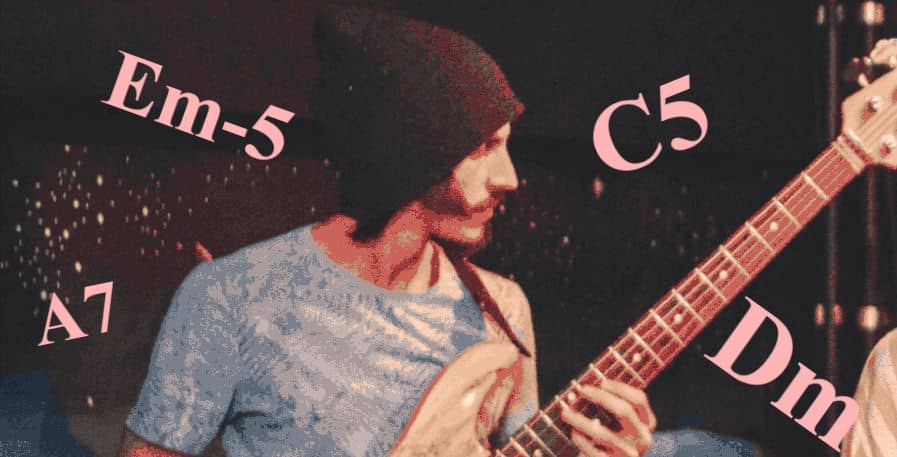When I first started out with the bass guitar, I was looking to strum bass chords from day one. This was mostly because I had seen Geddy Lee do it a couple of times and I thought it was the coolest thing ever.
I quickly learned though, that strumming even the most basic of bass chords wasn`t as easy as I thought. This was because they usually sounded muddy, and did more harm than good to my sound.
After playing the bass for 15 years, I`ve learned a thing or two about chords though. Therefore, I`ve made this list of easy bass chords that bassists of all skill levels can make use of.
Thus, by reading you will avoid the same mistakes I did when starting out. You will also learn about the different ways bassists play chords, what chords sound best when strummed, and what chords sound better arpeggiated.
As a result, you will learn how to use bass chords in the right situations in order to make your bass lines sound more interesting and unique.
Chords vs Dyads: Historically, 3 different pitches was required for a chord to be called a chord. It has however become commonplace to call harmonies with only 2 notes a chord as well. While these are technically called dyads, I will refer to them as chords in this article, as will most musicians in the real world.
1. Power Chords
Bass power chords are one of the most commonly played chords among 4-string players.
This is because power chords generally only consist of a root note and a perfect fifth. Sometimes variations of the chord include a high octave as well.
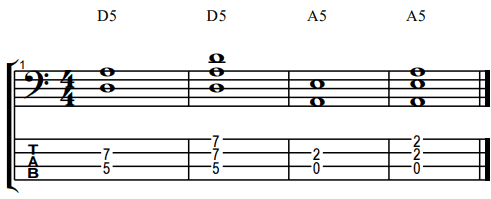
This gives the chord a harmonious and inoffensive character. At the same, power chords are great for making a bass sound like a guitar and adding punch and aggression to a song when they are strummed.
Furthermore, while bass chords sound muddy at lower registers, power chords can be played deeper than most other chords. This is due to the low interval limit, which makes other chords harder to distinguish at lower pitches than the simplistic power chord.
As a result, power chords are by far the most commonly strummed chord by bass players. In particular, you will find them fairly commonly used in rock and punk.
I like to use them for adding a bit of punch to songs during a chorus or crescendo. They can also be used as part of a bass riff, which is common in Les Claypool`s bass lines in Primus. Bass power chords can also be played as a full-out chord progression; commonly done by Mark Hoppus in Blink-182.
For some examples of how power chords have been used by various bass players, check out these songs:
- Motörhead – Ace Of Spades
- Primus – John The Fisherman
- Red Hot Chili Peppers – Snow (Hey Oh)
2. Inverted Power Chords
A less common, but equally basic bass chord is the inverted power chord. This chord consists of the same notes as a power chord. However, the perfect fifth of the chord is played below the root note instead of above it.
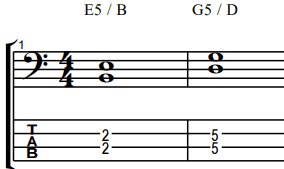
This gives the power chord a different tonal character. On its own, it can sound somewhat plain, but when listening to it in a chord progression it has a warm and dark character to it.
Inverted power chords work well in chord progressions and as part of riffs. A chord progression on the bass consisting solely of power chords can sound quite stale. Thus, throwing an inverted power chord or two into the mix is a quick way to make it more interesting.
Alternatively, the inverted power chord could be treated as a Sus4 chord. In this case, the deepest note would be considered the root, and the note above it would be considered the perfect fourth. This is a less common and less applicable way to use this voicing.
For examples of songs that have made use of inverted power chords, check out the following:
- Blink-182 – Always
- Joy Division – Atmosphere
- Tool – Schism
3. Major & Minor -5 Chords
The last example of a 2 note chord comes in the form of major and minor chords with an omitted fifth.
For example, a C Major chord would consist of a C, E, and a G. We can however opt to play just the C and the E, choosing to omit the G. This results in a Cmaj-5 chord.

These types of chords are less commonly found in bass lines than power chords but do still see a decent bit of use. Similar to power chords and inverted power chords, Major and minor -5 chords are well suited for being strummed on the bass guitar.
However, be careful about strumming -5 chords too deep on the bass. Despite only consisting of 2 notes, the minor third and the major third interval are harder to distinguish than the perfect fifth. Thus, these chords can sound muddier than the power chords when played on the bass.
With that said, these chords do work well when they are used intermittently at low or mid ranges. Alternatively, they can sound amazing when they are used for playing chord progressions and riffs high up on the bass.
For examples of minor and major -5 chords in bass lines, check out these songs:
- Rush – Vapor Trails
- NOFX – Stickin’ in My Eye
- Pearl Jam – Jeremy
4. Triads
Moving on to chords that consist of 3 different notes, let`s start with basic triads. Triads get their name from being a set of 3 notes that are all separated by a minor or major third interval.
The two types of triads that you will encounter the most are the major and minor triads. Compared to power chords and -5 chords, bass triads are rarely strummed.
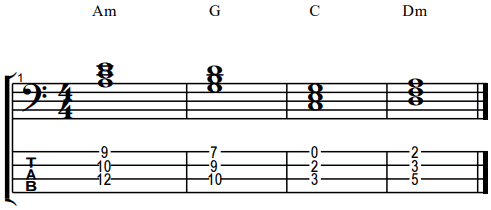
While dyads consisting of 2 notes sound clearer, Bass chords will start to sound muddy once we start introducing more harmony into them. As the minor and major third brings a lot of harmonic character to a chord, they are thus usually played one note at a time at deeper frequencies.
With that said, strumming triads can sound beautiful on the upper parts of the neck of the bass guitar. They can also be played deep to intentionally make the bass line sound grimy. For a strummed example of just that, check out Cliff Burton`s work on Metallica’s Orion.
For an example of triads being played one note at a time, listen to The Clash`s Guns of Brixton instead. This song has one of the most iconic bass intros of all time, despite it only being a minor triad played up and down.
5. Triads – 1st & 2nd Inversions
As triads consist of 3 notes, they can be played in a multitude of ways.
The most common way to do this is to change the deepest note of the triad. This means that instead of playing the root note at the bottom of the chord, we instead play the third or the fifth.
As detailed in my bass chord chart, chords of this kind are called slash chords. When the third is played as the deepest note, we call this the 1st inversion of the triad.
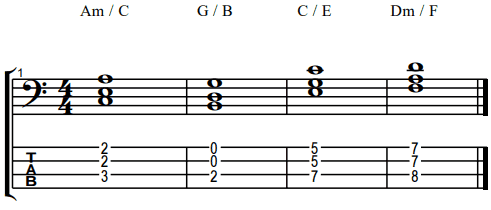
When the fifth is played instead, we call it the 2nd inversion of the triad.
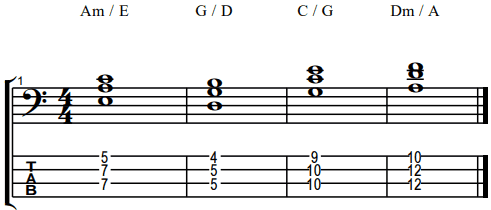
Changing the way we play a triad can add variety, change the melodic character, or make a bass line less cumbersome to play.
For example, when playing a chord progression that consists solely of minor and major triads without any inversions, my hands will tire out and start hurting quickly. However, by changing one of these triads to a first or second inversion, the line can become significantly easier on my hands.
Similarly, changing a triad to its 1st or 2nd inversion can make it sound a lot more interesting. Blindly defaulting to playing uninverted triads can make your bass lines more generic and less vital.
Thus, I highly recommend experimenting with inversions when playing bass chords. I mention this specifically for triads, as they are beginner-friendly chords that don`t get overly complicated when inverted.
6. Minor & Major Seventh Chords
The minor and major seventh chords are great for adding tension and character to bass lines.
How common seventh chords are varies greatly from genre to genre. They are for example, commonplace in jazz, and the most common jazz bass scales are often played over these chords. On the other hand, they are rare in rock and pop, and hardly ever found in genres like punk.
Minor seventh chords consist of a minor 3rd and 7th, whereas major seventh chords consist of a major 3rd and 7th.
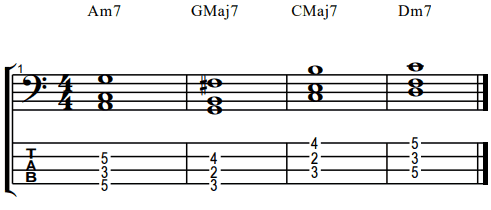
Similar to triads, seventh chords are generally not strummed, though they can be. Just bear in mind that strumming seventh chords will take up a lot of space harmonically, be very audible, and sound intense. For this reason, use them sparingly if you intend to strum them when playing with a band.
Playing major and minor seventh chords on the bass is most fitting towards the end of chord progressions. In this spot, the 7th adds additional tension to the progression, especially so when it is provided by the bass.
For arpeggiated examples of when to use this chord, listen to Overjoyed by Victor Wooten or Come On, Come Over by Jaco Pastorius. For a strummed example of how to use this chord, check out Marcus Miller`s Power instead.
7. Dominant Seventh Chords
Another type of chord that is great for providing tension is the dominant seventh chord.
I like to think of the dominant seventh chord as a hybrid between the minor seventh and major seventh chords. This is because the dominant seventh chord consists of a major third and a minor seventh.
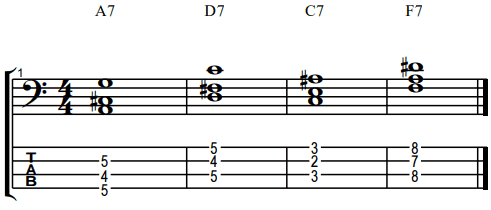
Just like the previous chords I`ve mentioned, dominant 7th chords can sound over the top when strummed. Thus, I recommend using them sparingly, especially so when playing deep on the fretboard.
The unique tonal character of dominant 7th chords can also both detract and add a lot to a song. Thus, this is a great type of chord to experiment with, as it will be harder to fit into songs than triads and power chords, but will add a lot more to it in spots where they fit.
For an example of how well dominant 7th chords can sound when strummed, listen to Groundhogs Day by Primus. Alternatively, for an example of how the chord sounds on the bass when notes are plucked individually, listen to Crossfire by Stevie Ray Vaughan.
Closing Words
In one sense, there is no such thing as basic bass chords. Playing two notes at a time on the 4-string already takes up a lot of space sonically, and could be considered an intermittent technique altogether.
With that said, there are some bass chords that are easier to play than others. More importantly, it`s also easier to find spots where they can be played in songs and when composing original bass lines.
I recommend starting out with power chords and inverted power chords. Then, when you get the hang of those, move on to major and minor chords where you leave out the fifth. Afterward, you can start to experiment with 3 note chords. At this point, I recommend focusing solely on triads and triad inversions.
Lastly, move on to seventh and dominant seventh chords. These are slightly tricker to incorporate into your lines, but add a lot more character to them when you are able to include them naturally.
Moving on from there, there is always some new chords to learn. Some next steps could include, Sus2 and Sus4 chords, or diminished and augmented chords.
I also recommend listening to as many bassists that use chords in their playing as possible. In particular, Victor Wooten`s You Can’t Hold No Groove, is a masterclass in how to play bass chords. Other notable players to draw inspiration from include Jaco Pastorius, Les Claypool, and Justin Chancellor.

